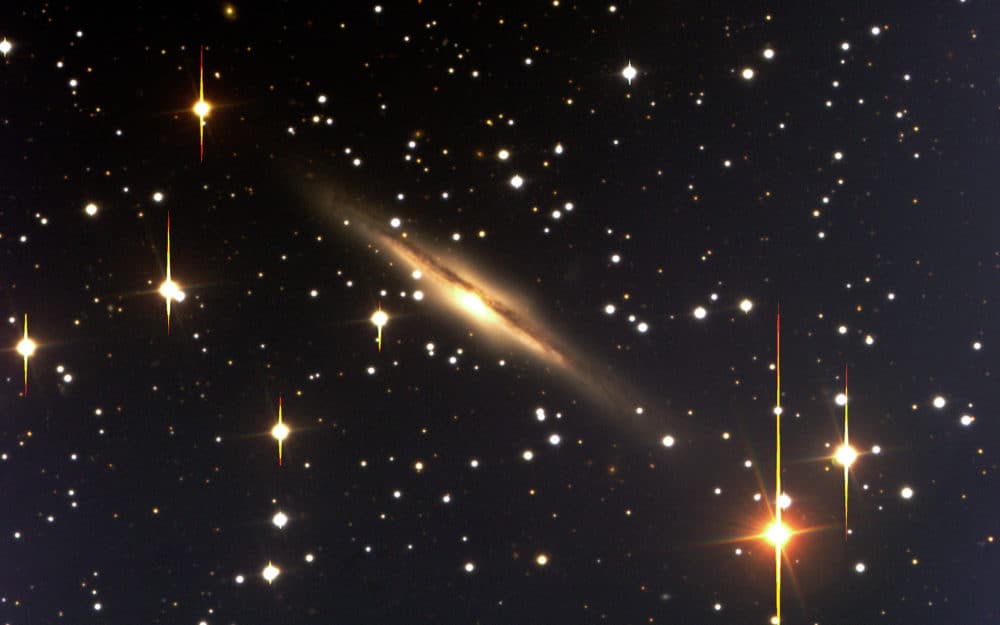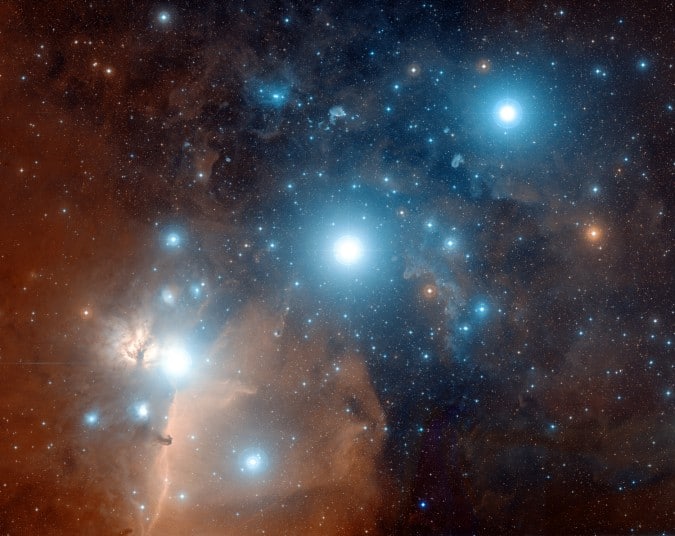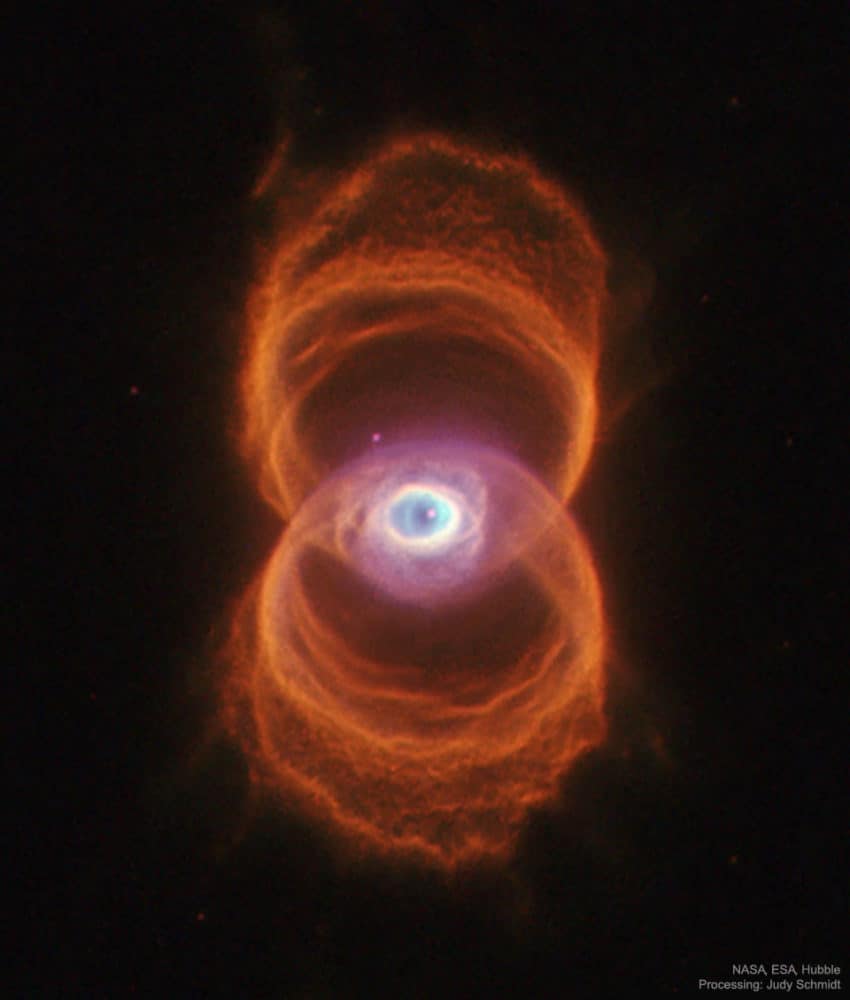Blog
This is a colour composite (BVR) of a sky field near the border between the southern constellations Carina (The Ship’s Keel) and Volans (The Flying Fish). It contains a spiral galaxy, ESO 60-24 that is seen nearly edge-on. This galaxy has a strong equatorial dust band that hides the light from the stars behind it. A bright centre is located just below the dust band and the spiral structure may be perceived in the outer regions. The velocity is 4,000 km/sec, corresponding to a distance of about 200 million light-years. These observations were made with FORS1 at ANTU on March 27, 1999. Field size: 6.8×6.8 arcmin 2 ; North is up and East is to the left.
more...Dave Holland (born 1 October 1946) is an English jazz double bassist, composer and bandleader who has been performing and recording for five decades. He has lived in the United States for over 40 years.
His work ranges from pieces for solo performance to big band. Holland runs his own independent record label, Dare2, which he launched in 2005. He has explained his musical philosophy by quoting fellow jazz artist Sam Rivers: “Sam said, ‘Don’t leave anything out – play all of it.'”
Holland has played with some of the greatest names in jazz, and has participated in several classic recording sessions. Born in Wolverhampton, England, Holland taught himself how to play stringed instruments, beginning at four on the ukulele, then graduating to guitar and later bass guitar. He quit school at the age of 15 to pursue his profession in a top 40 band, but soon gravitated to jazz. After seeing an issue of Down Beat where Ray Brown had won the critics’ poll for best bass player, Holland went to a record store, and bought a couple of LPs featuring Brown backing pianist Oscar Peterson. He also bought two Leroy Vinnegar albums (Leroy Walks! and Leroy Walks Again) because the bassist was posed with his instrument on the cover. Within a week, Holland traded in his bass guitar for an acoustic bass and began practicing with the records. In addition to Brown and Vinnegar, Holland was drawn to the bassists Charles Mingus and Jimmy Garrison.
https://www.youtube.com/watch?v=AkgaUrrF3s8
more...Albert Gene Drewery, known as Albert Collins and the Ice Man (October 1, 1932 – November 24, 1993), was an American electric blues guitarist and singer with a distinctive guitar style. He was noted for his powerful playing and his use of altered tunings and a capo. His long association with the Fender Telecaster led to the title “The Master of the Telecaster”.
Collins was born in Leona, Texas, on October 1, 1932. He was introduced to the guitar at an early age by his cousin Lightnin’ Hopkins, also a Leona resident, who played at family gatherings. The Collins family relocated to Marquez, Texas, in 1938 and to Houston in 1941 where he attended Jack Yates High School. Collins took piano lessons when he was young, but when his piano tutor was unavailable his cousin Willow Young would lend Albert his guitar and taught him the altered tuning that he used throughout his career. Collins tuned his guitar to an open F-minor chord (FCFAbCF), with a capo at the 5th, 6th or 7th fret. At the age of twelve, he decided to concentrate on learning the guitar after hearing “Boogie Chillen’” by John Lee Hooker. At eighteen Collins started his own group, the Rhythm Rockers, in which he honed his craft. During this time he was employed for four years at a ranch in Normangee, Texas; he then worked as a truck driver for various companies for twelve years.
Collins played an Epiphone guitar during his first two years with the Rhythm Rockers, but in 1952, after seeing Clarence “Gatemouth” Brown playing a Fender Esquire, he decided to purchase a Fender. He wanted a Telecaster, but because of the cost he chose to buy an Esquire, which he took to the Parker Music Company in Houston to be fitted with a Telecaster neck. This was his main guitar until he moved to California, and it was the guitar that he used on his earliest recordings, including his signature song, “Frosty”. For the rest of his career he played a “maple cap”–necked natural ash body Fender 1966 Custom Telecaster with a Gibson PAF humbucking pickup retrofitted into the neck position, which became the basis for a Fender Custom Artist signature model in 1990.
more...Alnitak, Alnilam, and Mintaka, are the bright bluish stars from east to west (left to right) along the diagonal in this gorgeous cosmic vista. Otherwise known as the Belt of Orion, these three blue supergiant stars are hotter and much more massive than the Sun. They lie about 1,500 light-years away, born of Orion’s well-studied interstellar clouds. In fact, clouds of gas and dust adrift in this region have intriguing and some surprisingly familiar shapes, including the dark Horsehead Nebula and Flame Nebula near Alnitak at the lower left. The famous Orion Nebula itself lies off the bottom of this star field that covers an impressive 4.4×3.5 degrees on the sky. The color picture was composited from digitized black and white photographic plates recorded through red and blue astronomical filters, with a computer synthesized green channel. The plates were taken using the Samuel Oschin Telescope, a wide-field survey instrument at Palomar Observatory, between 1987 and 1991.
more...Antonio Hart (born September 30, 1968) is a jazz alto saxophonist. He attended the Baltimore School for the Arts, studied with Andy McGhee at Berklee College of Music, and has a master’s degree from Queens College, City University of New York. His initial training was classical, but he switched to jazz in college. He gained recognition for his work with Roy Hargrove.
Hart is currently serving as a full-time professor of jazz studies in Aaron Copland School of Music at Queens College City University of New York.
Hart is a member of the Sigma chapter of Alpha Phi Alpha fraternity.
more...Oscar Pettiford (September 30, 1922 – September 8, 1960) was an American jazz double bassist, cellist and composer. He was one of the earliest musicians to work in the bebop idiom. Pettiford was born at Okmulgee, Oklahoma. His mother was Choctaw, and his father was half Cherokee and half African American.
He grew up playing in the family band in which he sang and danced before switching to piano at the age of 12, then to double bass when he was 14. He is quoted as saying he did not like the way people were playing the bass so he developed his own way of playing it. Despite being admired by the likes of Milt Hinton at the age of 14, he gave up in 1941 as he did not believe he could make a living. Five months later, he once again met Hinton, who persuaded him to return to music.
In 1942 he joined the Charlie Barnet band and in 1943 gained wider public attention after recording with Coleman Hawkins on his “The Man I Love“. Pettiford also recorded with Earl Hines and Ben Webster around this time. After he moved to New York, he was one of the musicians (together with Dizzy Gillespie, Thelonious Monk, Kenny Clarke) who in the early 1940s jammed at Minton’s Playhouse, where the music style developed that later was called bebop. He and Dizzy Gillespie led a bop group in 1943. In 1945 Pettiford went with Hawkins to California, where he appeared in The Crimson Canary, a mystery movie known for its jazz soundtrack, which also featured Josh White. He then worked with Duke Ellington from 1945 to 1948 and for Woody Herman in 1949 before working mainly as a leader in the 1950s.
As a leader he inadvertently discovered Cannonball Adderley. After one of his musicians had tricked him into letting Adderley, an unknown music teacher, onto the stand, he had Adderley solo on a demanding piece, on which Adderley performed impressively.
Pettiford is considered the pioneer of the cello as a solo instrument in jazz music. He first played the cello as a practical joke on his band leader (Woody Herman) when he walked off stage during his solo spot and came back, unexpectedly with a cello and played on that. In 1949, after suffering a broken arm, Pettiford found it impossible to play his bass, so he experimented with a cello a friend had lent him. Tuning it in fourths, like a double bass, but one octave higher, Pettiford found it possible to perform during his rehabilitation (during which time his arm was in a sling) and made his first recordings with the instrument in 1950. The cello thus became his secondary instrument, and he continued to perform and record with it throughout the remainder of his career.
https://www.youtube.com/watch?v=-lYBhfpZlUU
more...Bernard “Buddy” Rich (September 30, 1917 – April 2, 1987) was an American jazz drummer and bandleader. He is considered one of the most influential drummers of all time and was known for his virtuoso technique, power, and speed. He performed with Tommy Dorsey, Harry James and Count Basie, and led a big band. Rich was born in Sheepshead Bay, Brooklyn, New York, to Jewish-American parents Bess Skolnik and Robert Rich, both vaudevillians. As a kid, when he was at a restaurant with his parents, he used the knife and fork as drum sticks. Before he turned two, he was part of his parents’ act on vaudeville, but on breaks he would sneak into the orchestra pit and try to get the drummer’s sticks. He was on Broadway as Baby Traps the Drum Wonder at age four, playing “Stars and Stripes Forever” on a drum. He was a singer and tap dancer. In his teens he led a band and toured in the U.S. and Australia. At fifteen he became the second highest paid child entertainer behind Jackie Coogan during the 1930s.
Pippin the Musical performance today at the Mixed Blood Theater in Minneapolis presented by Theater 55. Sunday September 29th 2pm matinee Final Performance. Natalia Peterson on piano, Jamie Carter on guitar and mick laBriola percussion chair.
more...The rings of MyCn 18 trace the outline of an hourglass — although one with an unusual eye in its center. Either way, the sands of time are running out for the central star of this hourglass-shaped planetary nebula. With its nuclear fuel exhausted, this brief, spectacular, closing phase of a Sun-like star’s life occurs as its outer layers are ejected – its core becoming a cooling, fading white dwarf. In 1995, astronomers used the Hubble Space Telescope (HST) to make a series of images of planetary nebulae, including the one featured here. Pictured, delicate rings of colorful glowing gas (nitrogen-red, hydrogen-green, and oxygen-blue) outline the tenuous walls of the hourglass. The unprecedented sharpness of the Hubble images has revealed surprising details of the nebula ejection process that are helping to resolve the outstanding mysteries of the complex shapes and symmetries of planetary nebulas like MyCn 18.
The Engraved Hourglass Nebula (also known as MyCn 18) is a young planetary nebula in the southern constellation Musca. It was discovered by Annie Jump Cannon and Margaret W. Mayall during their work on an extended Henry Draper Catalogue (the catalogue was built between 1918 and 1924). At the time, it was designated simply as a small faint planetary nebula. Much improved telescopes and imaging techniques allowed the hourglass shape of the nebula to be discovered by Romano Coradi and Hugo Schwarz in images taken during 1991-1992 at the European Southern Observatory. It is conjectured that MyCn 18’s hourglass shape is produced by the expansion of a fast stellar wind within a slowly expanding cloudwhich is denser near its equator than its poles. The vivid colours given off by the nebula are the result of different ‘shells’ of elements being expelled from the dying star, in this case helium, nitrogen, oxygen and carbon.
more...Roy Sinclair Campbell Jr. (September 29, 1952 – January 9, 2014) was an American trumpeter frequently linked to free jazz, although he also performed rhythm and blues and funk during his career. Born in Los Angeles, California, in 1952, Campbell was raised in New York City. At the age of fifteen he began learning to play trumpet and soon studied at the Jazz Mobile program along with Kenny Dorham, Lee Morgan and Joe Newman. Throughout the 1960s, still unacquainted with the avant-garde movement, Campbell performed in the big bands of the Manhattan Community College. From the 1970s onwards he performed primarily within the context of free jazz, spending some of this period studying with Yusef Lateef.
In the early 1990s Campbell moved to the Netherlands and performed regularly with Klaas Hekman and Don Cherry. In addition to leading his own groups, he performed with Yo La Tengo, William Parker, Peter Brötzmann, Matthew Shipp, and other improvisors. Upon returning to the United Stateshe began leading his group Other Dimensions In Music and also formed the Pyramid Trio, a pianoless trio formed with William Parker. He died in January 2014 of hypertensive atherosclerotic cardiovascular disease at the age of 61.
more...Jean-Luc Ponty (born 29 September 1942) is a French jazz violinist and composer. Ponty was born into a family of classical musicians on 29 September 1942 in Avranches, France. His father taught violin, his mother taught piano. At sixteen, he was admitted to the Conservatoire National Supérieur de Musique de Paris, graduating two years later with the institution’s highest honor, Premier Prix (first prize). He was hired by the Concerts Lamoureux symphony in which he played for three years.
While still a member of the orchestra in Paris, Ponty picked up a side job playing clarinet (which his father had taught him) for a college jazz band that regularly performed at local parties. It proved life-changing. A growing interest in Miles Davis and John Coltrane compelled him to take up tenor saxophone. One night after an orchestra concert, and still wearing his tuxedo, Ponty found himself at a local club with only his violin. Within four years, he was widely accepted as the leading figure in “jazz fiddle”.
At that time, Ponty was leading a dual musical life: rehearsing and performing with the orchestra while also playing jazz until 3 a.m. at clubs throughout Paris. The demands of this schedule eventually brought him to a crossroads. Critic Joachim Berendt wrote that “Since Ponty, the jazz violin has been a different instrument”. At first, the violin proved to be a handicap; few at the time viewed the instrument as having a legitimate place in the modern jazz vocabulary. With a powerful sound that eschewed vibrato, Ponty distinguished himself with bebop phrasing and a punchy style influenced more by horn players than by anything previously tried on the violin. In 1964 at age 22 he released his debut album, Jazz Long Playing. He performed on stage in Basel, Switzerland, with string players Stuff Smith, Stéphane Grappelli, and Svend Asmussen. The performance was released as the album Violin Summit(1966).
John Lewis of the Modern Jazz Quartet invited Ponty to perform at the Monterey Jazz Festival in 1967, which led to a recording contract with the World Pacific and the albums Electric Connection(1969) with the Gerald Wilson Big Band and Jean-Luc Ponty Experience with the George Duke Trio (1969). That year also brought Sunday Walk (1967), the first collaboration between Ponty and Niels-Henning Orsted Pedersen.
https://www.youtube.com/watch?v=h9Ndr5Wl6aY
more...More Posts
- Nils-Aslak Valkeapää
- Louisiana Red
- Stick McGhee
- STOP THE WAR IN UKRAINE World Music with the Doox
- Daily Roots Willie Williams
- Cozmos Aurora Sweden
- Jon Hassell
- George Benson
- Fred Anderson
- World Music JORYJ KŁOC
- Daily Roots Culture
- Cozmos NGC 4571
- David Lindley
- Soloman Burke
- Otis Spann
- Manolis Chiotis
- Son House
- World Music Бумбокс Boombox
- Daily Roots with Kenyatta Hill
- Cozmos M51




